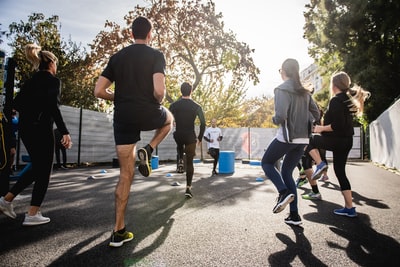Do you know the Importance of simplified fitness for diabetes control? This question may seem trivial, but its answer holds far-reaching implications for those managing diabetes. Simplified fitness, in essence, refers to finding practical and attainable ways to incorporate physical activity into daily routines.
It’s crucial to understand that regular exercise plays a pivotal role in controlling blood sugar levels for individuals with diabetes. However, the challenges that come with managing this chronic condition can often hinder one’s ability to engage in complex exercise regimens.
This is where simplified fitness steps in, offering a more accessible approach to stay active even amidst the busiest of schedules. The overarching goal is to simplify fitness routines, making them both achievable and sustainable.
With this article, we delve into the multifaceted benefits that simplified fitness holds in diabetes control and explore practical strategies that can empower individuals with diabetes to lead active and healthy lives. So, join us on this enlightening journey as we navigate the symbiotic relationship between simplified fitness and managing diabetes!

Table of Contents
Understanding the link between fitness and diabetes
Incorporating regular exercise into your routine is crucial for maintaining blood sugar levels and overall health. Exercise improves insulin sensitivity and helps lower blood sugar levels. To choose the right exercises for diabetes management, opt for low-impact activities that can be easily modified for your fitness level. Walking, swimming, cycling, and yoga are great options that provide cardiovascular and strength benefits.
Simplifying your fitness routine is important, especially if you have a busy schedule. By dedicating a few minutes each day to exercise, you can greatly improve your diabetes control. Monitor your blood sugar levels before, during, and after physical activity to avoid complications. Regular exercise not only helps manage diabetes but also reduces the risk of developing other related health conditions.
Choosing the right exercises for diabetes management
To simplify and make your fitness routine more achievable and sustainable, start by selecting exercises you enjoy and that can fit into your daily schedule. Walking or swimming, for example, are low-impact activities that are great for cardiovascular exercise. Resistance band workouts or using light weights can also help build muscle and increase metabolism. Consistency is crucial, so make it a priority to incorporate movement into your daily routine, like taking the stairs instead of the elevator or going for a brisk walk during your lunch break. By simplifying your fitness routine and prioritizing it, you can effectively manage your diabetes and improve your overall health.
When managing diabetes, it’s important to choose exercises that are suitable for your fitness level and can be adjusted as needed. Yoga is an excellent option because it is low-impact and focuses on flexibility and strength. Yoga poses can be modified to accommodate different physical abilities, ensuring safety and effectiveness for everyone.
Mind-body exercises like yoga can also help reduce stress levels, which is especially beneficial for individuals with diabetes as stress can affect blood sugar control. Remember to listen to your body and consult with a healthcare professional before starting a new exercise routine. By selecting exercises that suit your needs and can be modified as necessary, you can effectively manage your diabetes and improve your overall fitness and well-being.
Creating a simplified fitness routine for busy schedules
Simplifying your fitness routine is crucial for managing diabetes when you have a busy schedule. Start by adding short bursts of physical activity throughout the day. For example, take the stairs instead of the elevator or do quick stretching exercises during work breaks. These small actions can accumulate and enhance your overall fitness. Additionally, try high-intensity interval training (HIIT) workouts. These workouts involve intense exercise followed by short rest periods. Compared to traditional exercise routines, HIIT workouts take less time and offer similar health benefits.
Even small pockets of dedicated time for physical activity can greatly help in managing diabetes.
Another way to simplify your fitness routine is by incorporating enjoyable activities. Find an exercise that brings you joy, such as dancing, playing a sport, or hiking, and make it a regular part of your routine. When you genuinely enjoy an activity, you are more likely to stick with it and experience the benefits of consistent exercise.
Additionally, consider finding a fitness buddy or joining a group class to increase accountability and make your workouts more enjoyable. Remember, the goal is to make fitness a sustainable part of your life, so finding activities that align with your interests and schedule can significantly contribute to effectively managing diabetes.
Monitoring blood sugar levels during physical activity
Monitoring blood sugar levels during exercise is crucial for managing diabetes. Before exercising, it is essential to check blood sugar levels to ensure they are in a safe range. If levels are too low, eating a small carbohydrate-rich snack can prevent hypoglycemia. If levels are too high, it may be best to delay exercise until they stabilize.
Continuously monitoring blood sugar levels during the workout is important, especially for longer or more intense activities. This allows for necessary adjustments like altering insulin doses or consuming carbohydrates to maintain balanced blood sugar levels.
Various methods can be used to monitor blood sugar levels during exercise. Continuous glucose monitoring (CGM) devices are particularly helpful as they provide real-time tracking and alerts for low or high levels. Fingerstick glucose testing is another option, although it may not be as convenient during physical activity.
Regardless of the method chosen, it is important to keep monitoring equipment easily accessible and be familiar with its usage for quick checks when needed. By effectively monitoring blood sugar levels, informed decisions can be made about managing diabetes during exercise, ensuring a safe and successful workout.
The benefits of regular exercise for diabetes control
Regular exercise has numerous benefits for people with diabetes. It improves insulin sensitivity and blood sugar regulation, prevents and manages diabetes complications, boosts energy levels, and enhances cardiovascular health. Additionally, exercise reduces the risk of heart disease in individuals with diabetes.
voicedrop.ai tagapp.ai2seo.com tag
Empowering Individuals with Diabetes: Simplifying Fitness Strategies for Better Health
BeFitnessPlan – Everything About Health Fitness is a valuable resource for individuals seeking simplified fitness strategies for diabetes management. With its comprehensive website, users can access a wealth of information and resources to aid in their journey towards better health.
The platform offers a wide range of articles, videos, and tips, covering various topics crucial to diabetes management, including exercise routines, nutrition, weight loss, and mental well-being. By providing easily accessible and understandable content, BeFitnessPlan empowers those with diabetes to take control of their health and achieve their fitness goals.
Whether it’s learning about the best exercises to regulate blood sugar levels or understanding the importance of a balanced diet, this platform ensures that individuals have all the necessary tools to effectively manage their condition. So, embrace the simplified approach offered by BeFitnessPlan and pave the way to a healthier lifestyle.
Frequently Asked Questions
Simplified fitness refers to the concept of incorporating easy-to-follow exercise routines and healthy habits into daily life in order to improve overall fitness and well-being.
Simplified fitness can help manage diabetes by promoting regular physical activity, which can improve insulin sensitivity, regulate blood sugar levels, control weight, and reduce the risk of developing complications related to diabetes.
Some examples of simplified fitness activities include brisk walking, cycling, swimming, yoga, bodyweight exercises, and gardening.
No, it is not necessary to join a gym or have fancy equipment for simplified fitness. Simple activities like walking or doing bodyweight exercises at home can be highly effective.
Yes, along with simplified fitness, it is recommended to follow a healthy and balanced diet that limits processed foods, focuses on whole grains, lean proteins, fruits, and vegetables, and controls portion sizes.
Simplified fitness cannot replace medications for diabetes. It is important to consult with a healthcare professional to determine the appropriate treatment plan, which may include a combination of medication, diet, and exercise.
If you have other health conditions besides diabetes, it is advisable to consult with your healthcare provider before starting any new fitness program to ensure it is safe and tailored to your specific needs.
The American Diabetes Association recommends at least 150 minutes of moderate-intensity aerobic activity, such as brisk walking, spread over a minimum of three days per week, along with muscle-strengthening activities at least two days per week.
The Bottom Line
In conclusion, embracing a simplified fitness routine has proven to be immensely beneficial for the management of diabetes. As we navigate through the complexities of this condition, it becomes increasingly evident that incorporating regular physical activity into our daily lives can yield remarkable results.
The amalgamation of aerobic exercises, such as walking or cycling, with strength training exercises can enhance insulin sensitivity and improve blood sugar control. It is imperative to remember that even small steps towards a more active lifestyle can make a world of difference.
Engaging in activities that bring joy and satisfaction, whether it involves dancing or swimming, can significantly increase adherence to a fitness regimen. Furthermore, the utilization of technological advancements, such as wearable devices and smartphone applications, can further simplify the tracking of fitness goals and encourage individuals to stay on track.
Remember, fitness is not a one-size-fits-all concept, and embracing a tailored approach can empower individuals to take charge of their diabetes management. With education, support, and a determination to prioritize self-care, individuals with diabetes can unlock the transformative power of fitness and emerge as champions of their own health.





